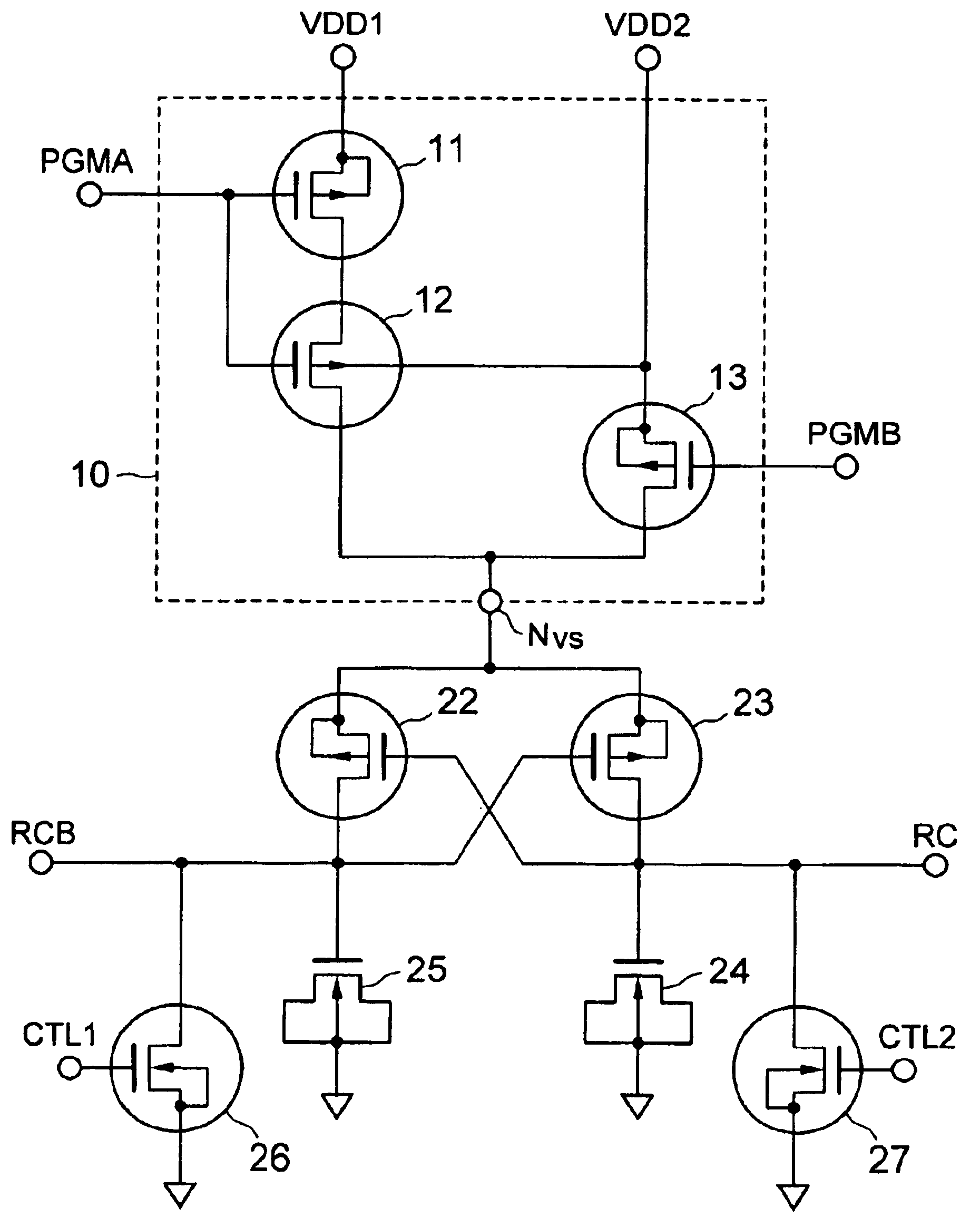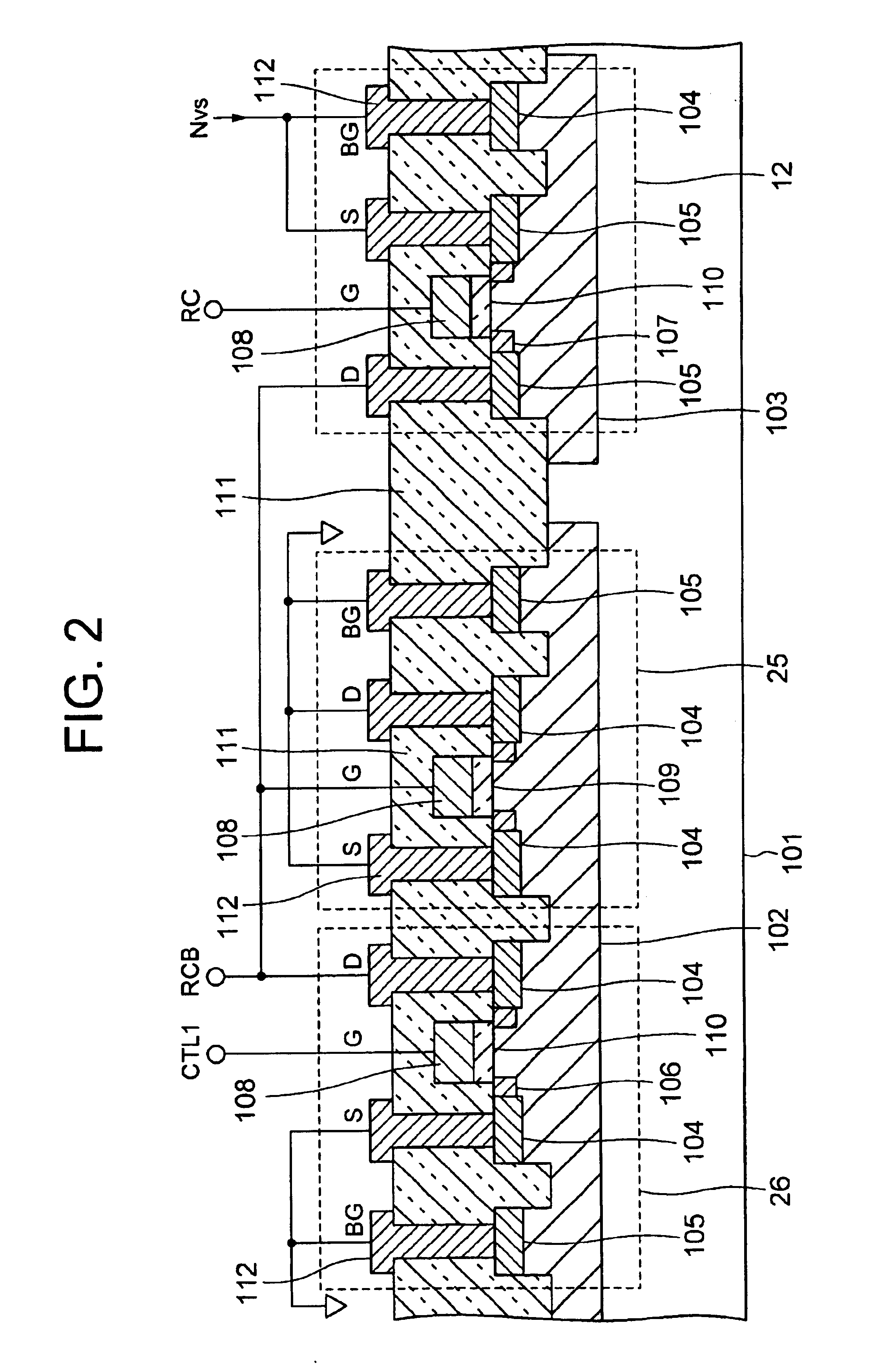Data latch circuit having anti-fuse elements
a latch circuit and anti-fuse element technology, applied in the direction of computation using denominational number representation, pulse technique, instruments, etc., can solve the problem of difficult to judge whether the anti-fuse element is conductive or non-conductive, and it is difficult to perfectly exclude the defects of some memory cells during the manufacturing of the memory circui
- Summary
- Abstract
- Description
- Claims
- Application Information
AI Technical Summary
Benefits of technology
Problems solved by technology
Method used
Image
Examples
first embodiment
Referring to FIG. 1, a data latch circuit according to the present invention includes a voltage selection block 10, pMOSFETs 22 and 23 constituting a latching block, nMOSFETs 26 and 27 for setting programming data, and nMOSFETs 24 and 25 constituting capacitive anti-fuse elements to be programmed with a logic level "1" or "0". The logic level "1" to be stored in the data latch circuit effects dielectric breakdown of the gate insulation film of anti-fuse element 25, whereas logic level "0" effects dielectric breakdown of the gate insulation film of anti-fuse element 24.
The data latch circuit of FIG. 1 reads and latches the logic level stored in the anti-fuse elements 24 and 25 to deliver the latched logic level through output terminal RC and inverted latched logic level through output terminal RCB. The gate insulation films of nMOSFETs 24 and 25 have a first thickness, whereas the gate insulation films of pMOSFETs 22 and 23 and nMOSFETs 26 and 27 have a second thickness larger than t...
third embodiment
Referring to FIG. 5, a data latch circuit according to the present invention is similar to the data latch circuit of FIG. 1 except for the configuration of the voltage selection block.
More specifically, the voltage selection block 10a shown in FIG. 5 includes a pair of pMOSFETs 12 and 13. The pMOSFET 12 includes a gate insulation film having the second thickness, a source connected to the first power source VDD1, a gate receiving programming control signal PGMA, a drain connected to voltage selection node Nvs and a backgate connected to the second power source VDD2. The pMOSFET 13 includes a gate insulation film having the second thickness, source and backgate connected together to the second power source VDD2, a gate receiving programming control signal PGMB, and a drain connected to voltage selection node Nvs.
In the voltage selection block 10a, if the voltage of the second power source VDD2 becomes lower than the voltage of the first power source VDD1 due to an accidental cause su...
sixth embodiment
Referring to FIG. 8A, there is shown a semiconductor chip implementing a semiconductor integrated circuit including a remedy circuit 49 in a memory macro block 42, the remedy circuit 49 including a plurality of data latch circuits according to a
The semiconductor chip 41 mounts thereon the memory macro block 42, a plurality of internal logic macro blocks 43, I / O circuit blocks 44, power I / O pad 45 for the first power source VDD1, power I / O pad 46 for the second power source VDD2, and signal I / O pads 47. The I / O circuit block 44 receives both the voltages of the first and second power sources VDD1 and VDD2 from power I / O pads 45 and 46, respectively, whereas the logic macro block 43 receives the normal operating voltage Vop of the first power source VDD1 from the power I / O pad 45. The signals input through the signal I / O pads 47 are delivered to the logic macro blocks 43 after voltage conversion in the I / O circuit blocks 44 to the normal operating voltage Vop. The signals delivered fr...
PUM
 Login to View More
Login to View More Abstract
Description
Claims
Application Information
 Login to View More
Login to View More - R&D
- Intellectual Property
- Life Sciences
- Materials
- Tech Scout
- Unparalleled Data Quality
- Higher Quality Content
- 60% Fewer Hallucinations
Browse by: Latest US Patents, China's latest patents, Technical Efficacy Thesaurus, Application Domain, Technology Topic, Popular Technical Reports.
© 2025 PatSnap. All rights reserved.Legal|Privacy policy|Modern Slavery Act Transparency Statement|Sitemap|About US| Contact US: help@patsnap.com



